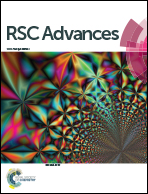Ag nanowires as precursors to synthesize Ag–ZnO nanostructured brushes†
Abstract
Ag–ZnO nanostructured brushes (NBs) were synthesized by the precipitation method. From this study, it was observed that a key parameter to grow these unidirectional structures is the seeding through Ag nanowires. SEM analysis showed that the Ag nanowires serve as templates in the formation of Ag–ZnO NBs with a one-directional shape. The absence of Ag nanowires leads to the radial growth of ZnO with a star-shaped morphology. The obtained Ag–ZnO unidirectional structures have potential catalytic, bactericide, and conducting applications, and may also find application as a nanorotor.


 Please wait while we load your content...
Please wait while we load your content...